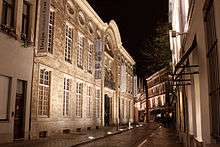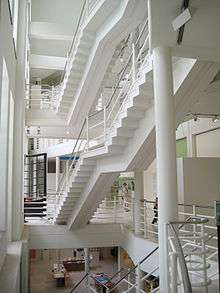Design Museum Gent
| Vereniging voor Nijverheids- en Decoratieve Kunsten | |
 | |
 Location within Belgium | |
| Established | 1989 |
|---|---|
| Location | Ghent, Belgium |
| Coordinates | 51°03′21″N 3°43′13″E / 51.055833°N 3.720139°E |
| Director | Katrien Laporte |
| Public transit access |
Korenmarkt Gravensteen |
| Website | designmuseumgent.be/en |
Design museum Gent is a museum founded in 1903, located in the historical centre of the Belgian city of Ghent.
The permanent collection of the museum includes some important seventeenth and eighteenth century interiors, however, the museum focuses on twentieth-century and contemporary design.
History

The origins of Design museum Gent lie in the 'Association of Industrial and Decorative Arts', founded in Ghent in 1903 and housed in the Academy of Fine Arts. Originally, the museum exhibited models: good examples of furniture, frames, mirrors, ceramics, copper, bronze and textiles were on display for designers and artisans. After the First World War, contemporary applied art started getting noticed. Due to the large number of bequethed objects, the space in the Academy had become too small. So, in 1922 the museum moved to Hotel de Coninck in the Jan Breydel Street, which the city of Ghent had bought a couple of years earlier. In 1951, under the leadership of a new director, Adelbert Van de Walle, three successful shows called the "National Salons for Modern Social Furniture" were introduced in 1955, 1956, and 1957.[1] These shows invited local manufacturers to exhibit their furniture showcased in rooms as fictitious domestic environments and to take orders placed by visitors – the museum's effort to display and distribute modern, affordable design.[1] By 1958, the financial burden had become too much for the 'Association of Industrial and Decorative Arts', resulting in the city of Ghent taking over the administration and management of the museum.
In 1992, Design museum Gent has been expanded. The new extension is designed by architect Willy Verstraete and was officially opened in May 1992. In the modern part of the building, a huge hydraulic lift in the central section can be used to make the floors adaptable.
Collections
In 1975, the museum chose to limit its active acquisitions to design from Art Nouveau onwards. The collection and exhibition policy focuses on twentieth-century and contemporary design. Since the museum's inception, the collection development is mainly focused on collecting artifacts from the private residence. The focus is primarily on the living room, dining room, kitchen, study, bedroom and garden. Besides the permanent collection, realizations of young Belgian jewelery, furniture and ceramic designers are on display constantly.
Art Nouveau
Design museum Gent has one of the most superb Art Nouveau collections in Belgium. Alongside foreign designers, the works of important Belgian artists like Henry van de Velde, Victor Horta, Paul Hankar, Gustave Serrurier-Bovy and Philippe Wolfers are in its collection.
Art Deco
Art Deco and the applied arts from the inter-war years are represented by Albert Van huffel, Chris Lebeau, Gaston Eysselinck, Le Corbusier, Emile Lenoble, Gabriel Argy-Rousseau, Jean Sala, Jean Puiforcat, Maurice Marinot, Claudius Linossier, Emile Ruhlmann and Huib Hoste.
1970s and 1980s
The collections from the seventies and eighties are dominated on the one hand by the more important Belgian designers like Pieter De Bruyne and Emiel Veranneman, and on the other by Italian design, particularly from groups like Alchimia and Memphis, Ettore Sottsass, Nathalie Du Pasquier, Michele de Lucchi, Martine Bedin, Massimo Iosa-Ghini, Michael Graves, Alessandro Mendini, Marco Zanini en Mateo Thun.
Postmodernism
Furniture, glass and ceramics by Borek Sipek, and the work of Richard Meier, Hans Hollein, Aldo Rossi.
-

Tupperware exhibition
-
Room in Hotel de Coninck
-

.03 by Maarten Van Severen